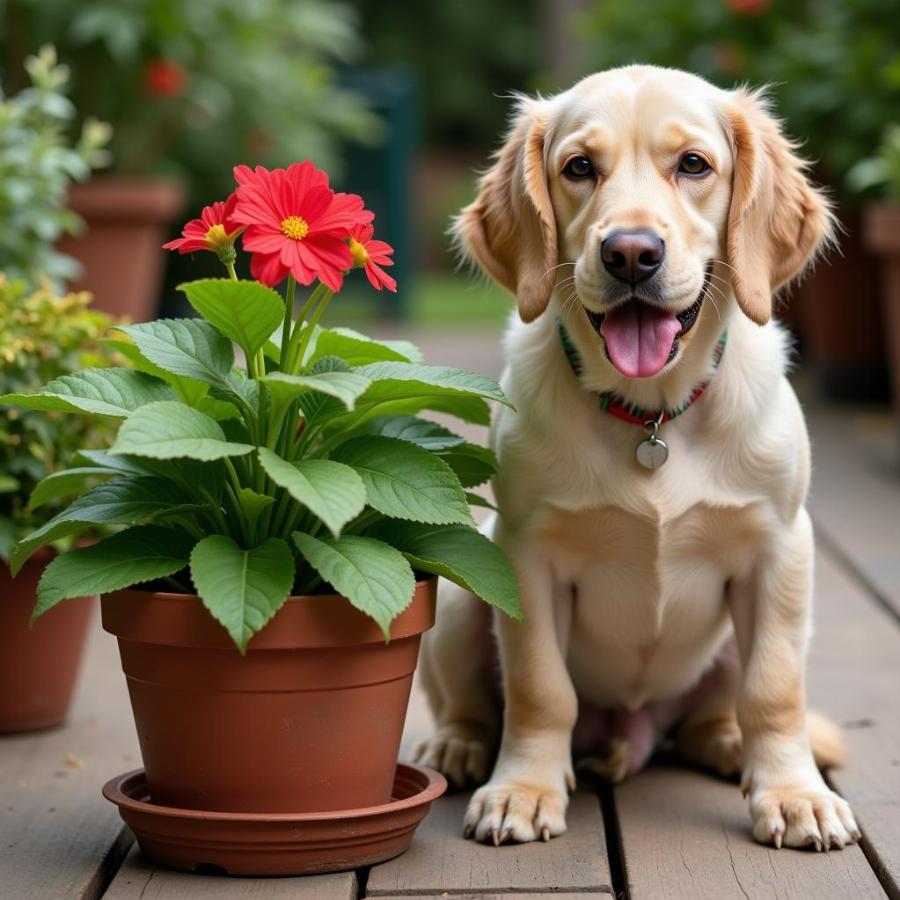Dipladenia, also known as Mandevilla, is a popular flowering vine cherished for its vibrant blooms. However, if you’re a dog owner, you must be aware that dipladenia is indeed toxic to dogs. This beautiful plant contains cardiac glycosides, which can cause a range of unpleasant and potentially dangerous symptoms if ingested. Knowing the risks and taking preventative measures is crucial to keeping your furry friend safe.
Understanding Dipladenia Toxicity in Dogs
Dipladenia’s toxicity stems from the cardiac glycosides present in all parts of the plant, including the leaves, stems, flowers, and roots. These glycosides disrupt the heart’s normal rhythm, which can lead to various health problems for your dog. The level of toxicity can vary depending on the specific cultivar and the amount ingested, but it’s always best to err on the side of caution and assume any amount is potentially harmful.
 Dipladenia and a Dog
Dipladenia and a Dog
While mild cases of dipladenia poisoning may only cause gastrointestinal upset, more severe cases can lead to life-threatening cardiac complications. Understanding the signs of dipladenia poisoning is crucial for early intervention and treatment.
Signs and Symptoms of Dipladenia Poisoning in Dogs
If your dog ingests dipladenia, you might observe a range of symptoms, including:
- Vomiting
- Diarrhea
- Loss of appetite
- Lethargy
- Weakness
- Drooling
- Abdominal pain
- Changes in heart rate (either faster or slower)
- Difficulty breathing
- Tremors
- Seizures
- Collapse
If you suspect your dog has ingested any part of a dipladenia plant, seek immediate veterinary attention. Early diagnosis and treatment are crucial for a positive outcome.
What to Do If Your Dog Ingests Dipladenia
Time is of the essence if you think your dog has eaten dipladenia. Here’s what you should do:
- Remove your dog from the area: This prevents further ingestion of the plant.
- Contact your veterinarian or the ASPCA Animal Poison Control Center immediately: They can provide specific advice and guidance based on your dog’s breed, size, and the amount of dipladenia ingested.
- Do not induce vomiting unless instructed by a veterinarian: Inducing vomiting incorrectly can sometimes worsen the situation.
- Bring a sample of the plant to the vet: This helps them identify the toxin and determine the best course of treatment.
Preventing Dipladenia Poisoning
The best way to protect your dog from dipladenia poisoning is to prevent access to the plant altogether. Here are some preventive measures:
- Keep dipladenia plants out of reach: Place them on high shelves, hanging baskets, or in enclosed areas where your dog cannot access them.
- Train your dog to avoid the plant: Teach commands like “leave it” or “drop it” to discourage your dog from interacting with the plant.
- Supervise your dog closely when outdoors: If you have dipladenia in your garden, ensure your dog is always supervised and prevented from chewing on or ingesting any plants.
- Consider alternative, non-toxic plants: If you’re concerned about your dog’s safety, opt for pet-friendly plants that won’t pose a threat to their health.
Conclusion
Dipladenia, while visually appealing, poses a real danger to dogs. By understanding the risks, recognizing the symptoms of poisoning, and taking appropriate preventative measures, you can ensure your furry friend stays safe and healthy while still enjoying the beauty of your garden. Remember, swift action is crucial if you suspect your dog has ingested dipladenia, so always contact your veterinarian immediately if you have any concerns.
FAQ
- Is all parts of the dipladenia plant toxic? Yes, all parts of the dipladenia plant, including the leaves, stems, flowers, and roots, are toxic to dogs.
- What are the most common symptoms of dipladenia poisoning in dogs? The most common symptoms include vomiting, diarrhea, loss of appetite, and lethargy.
- What should I do if my dog eats dipladenia? Immediately contact your veterinarian or the ASPCA Animal Poison Control Center for guidance.
- How can I prevent my dog from eating dipladenia? Keep the plant out of reach, train your dog to avoid it, and supervise your dog closely outdoors.
- Are there any safe alternatives to dipladenia? Yes, there are many pet-friendly plants that you can choose from.
Beaut Dogs is your ultimate resource for all things dog-related. We offer expert advice, helpful tips, and in-depth information to ensure your canine companion thrives. For personalized support, contact us at Email: [email protected]. Beaut Dogs is committed to providing dog owners with the knowledge and resources they need to provide the best possible care for their beloved pets.